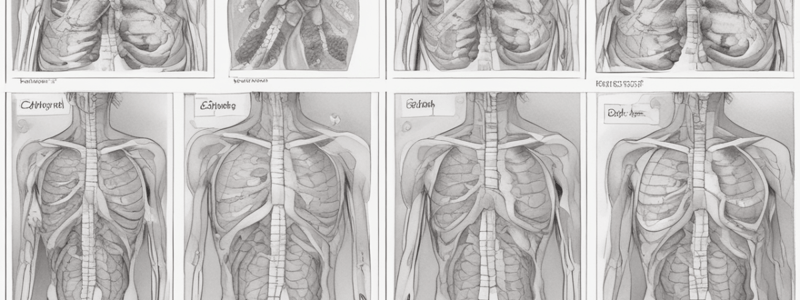Podcast
Questions and Answers
What is the most common condition associated with secondary spontaneous pneumothorax?
What is the most common condition associated with secondary spontaneous pneumothorax?
- Chronic obstructive pulmonary disease (COPD) (correct)
- Pulmonary thromboembolism
- Reactive airway disease
- Decompression sickness
What is the classic radiograph finding for pneumothorax?
What is the classic radiograph finding for pneumothorax?
- A dense opacity in the lung field
- A thin, visceral, pleural line lying parallel to the chest wall, separated by a radiolucent band that is devoid of lung markings (correct)
- Consolidation of the lung parenchyma
- Hyperinflation of the lungs
If the initial chest X-ray is negative, what additional imaging modality may be used to evaluate for pneumothorax?
If the initial chest X-ray is negative, what additional imaging modality may be used to evaluate for pneumothorax?
- D-dimer
- Echocardiogram
- V/Q scan
- Inspiratory and expiratory films or a lateral decubitus film (correct)
What is the purpose of a D-dimer test in the workup of this patient's dyspnea?
What is the purpose of a D-dimer test in the workup of this patient's dyspnea?
What is the purpose of a V/Q scan in the workup of this patient's dyspnea?
What is the purpose of a V/Q scan in the workup of this patient's dyspnea?
Which of the following is the most appropriate next step in the evaluation of this patient's pneumothorax?
Which of the following is the most appropriate next step in the evaluation of this patient's pneumothorax?
What is the most appropriate next step in managing this patient's respiratory distress?
What is the most appropriate next step in managing this patient's respiratory distress?
Which X-ray view of the chest is most likely to detect a small pleural effusion in the patient described?
Which X-ray view of the chest is most likely to detect a small pleural effusion in the patient described?
What is the most likely cause of the soot in the patient's upper airway?
What is the most likely cause of the soot in the patient's upper airway?
Which condition can present with decreased breath sounds at the lung base?
Which condition can present with decreased breath sounds at the lung base?
What is the most appropriate intervention for a suspected foreign-body aspiration?
What is the most appropriate intervention for a suspected foreign-body aspiration?
Which condition is characterized by diffuse rhonchi bilaterally on physical examination?
Which condition is characterized by diffuse rhonchi bilaterally on physical examination?
Which of the following is the most common cause of mediastinal shift and decreased venous return leading to severe hypotension?
Which of the following is the most common cause of mediastinal shift and decreased venous return leading to severe hypotension?
What is the first appropriate step to take when a patient presents with absent breath sounds over the left lung?
What is the first appropriate step to take when a patient presents with absent breath sounds over the left lung?
Which of the following is the most effective method for detecting small pleural effusions?
Which of the following is the most effective method for detecting small pleural effusions?
What is the most likely cause of the severe inflammatory reaction and pneumonitis in a patient with singed nasal hairs?
What is the most likely cause of the severe inflammatory reaction and pneumonitis in a patient with singed nasal hairs?
Which of the following is the most appropriate first-line treatment for a patient with a tension pneumothorax?
Which of the following is the most appropriate first-line treatment for a patient with a tension pneumothorax?
Which of the following is the most common cause of decreased venous return leading to severe hypotension?
Which of the following is the most common cause of decreased venous return leading to severe hypotension?
Flashcards are hidden until you start studying




